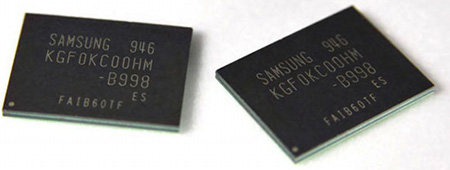’20nm-class’ 64Gb flash chips use DDR2
May 13, 2011 — by LinuxDevices Staff — from the LinuxDevices Archive — viewsSamsung announced what it calls “the industry's first production of a high-performance toggle DDR 2.0 multi-level-cell (MLC) memory chip.” The 64 gigabit (Gb) chips will target smartphones, tablets, and solid-state disks (SSDs), and are created using an “advanced 20-nanometer (nm) class process,” the company says.
According to Samsung, its new 64Gb MLC chip will use a DDR2 interface, transmitting data with a bandwidth of up to 400 megabits per second (Mbps). It's said this will provide a 10x increase over the 40Mbps Single Data Rate (SDR) NAND flash memory in widespread use today, and a 3x boost over the 133Mbps DDR 1.0 32Gb NAND flash that Samsung was first to produce in 2009.

Samsung's 64GB flash chips will use a DDR2 interface
Samsung says the new 64Gb MLC NAND chip offers an approximate 50-percent increase in productivity over the 32Gb MLC NAND chips — similarly described as "20nm-class" — it started producing last April. The chip more than doubles the speed of 30nm-class 32Gb MLC NAND, the company adds.
When Samsung rolled out its 32Gb chips last year, observers such as EETimes' Mark LaPedus pointed out that what Samsung touts as "20nm-class" is actually something more like a 27nm part. A footnote in Samsung's latest release now concedes as much, stating, "'20nm-class' means a process technology node somewhere between 20 and 29 nanometers, while '30nm-class' means a process technology node somewhere between 30 and 39 nanometers."
Samsung's rivals are still ahead, therefore, in ongoing efforts to make flash chips smaller and more information-dense. Intel and Micron announced in April that they've begun sampling 20nm flash technology, and the SanDisk/Toshiba partnership said later the same month that it would begin sampling 19nm-fabbed 64Gb flash chips this quarter.
Samsung, however, suggests that the 400Mbps bandwidth of the toggle DDR2 interface will give its flash chips an edge. This will "better support the ongoing shift toward advanced interfaces, as more mobile and consumer electronics devices requiring added performance and higher densities adopt new interfaces such as USB 3.0 and SATA 6.0Gbps," the company stated.
Availability
Samsung's announcement did not say when the company's 64GB DDR2 flash chips will become available to manufacturers. As Lawrence Latif comments in an item for The Inquirer, however, Samsung was the first to produce a working DDR1 32Gb flash module in 2009, but the unit didn't go into mass production until April 2010. He writes, "That means it'll be a few months yet before manufacturers can get their hands on Samsung's latest and greatest flash chips."
Jonathan Angel can be reached at [email protected] and followed at www.twitter.com/gadgetsense.
This article was originally published on LinuxDevices.com and has been donated to the open source community by QuinStreet Inc. Please visit LinuxToday.com for up-to-date news and articles about Linux and open source.